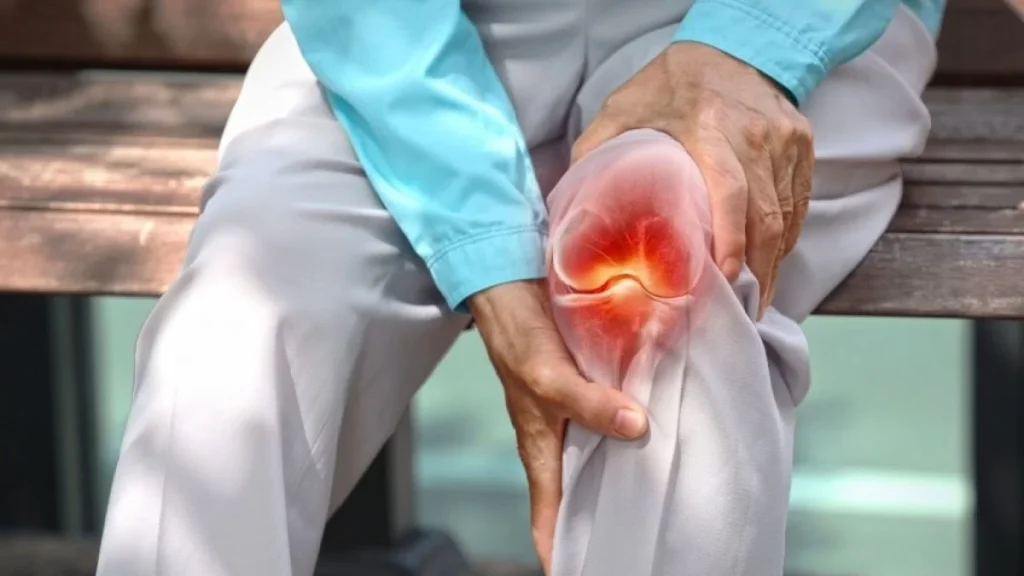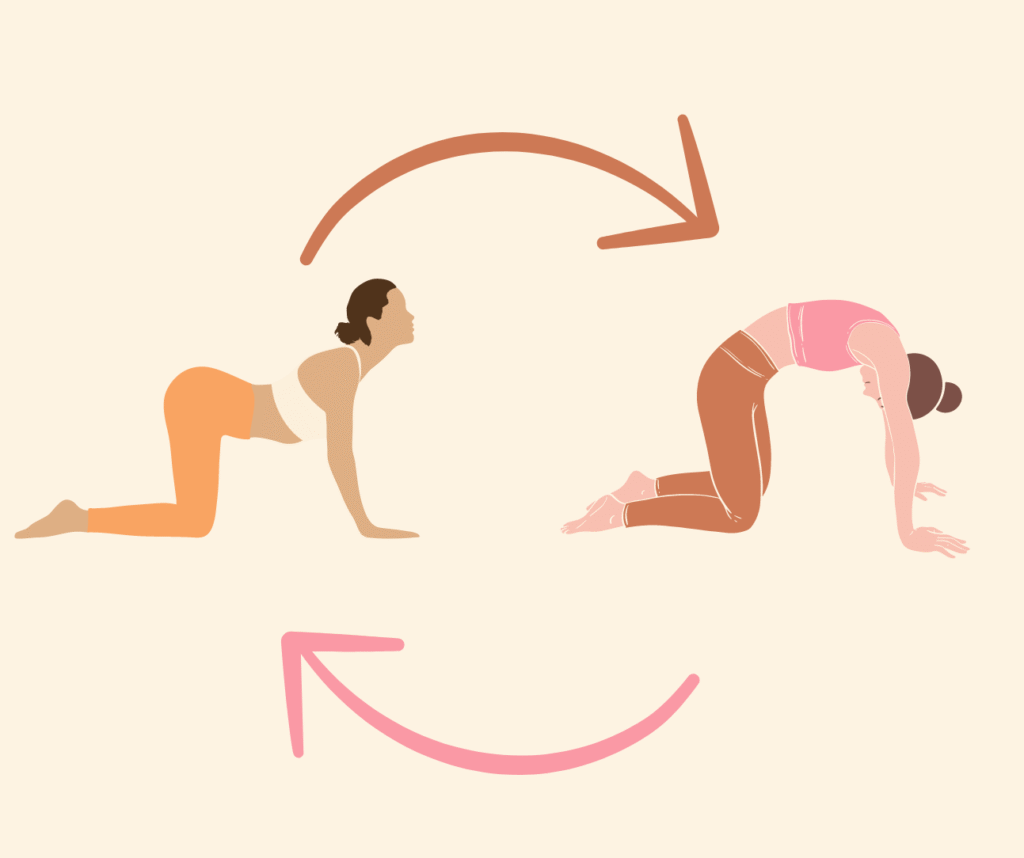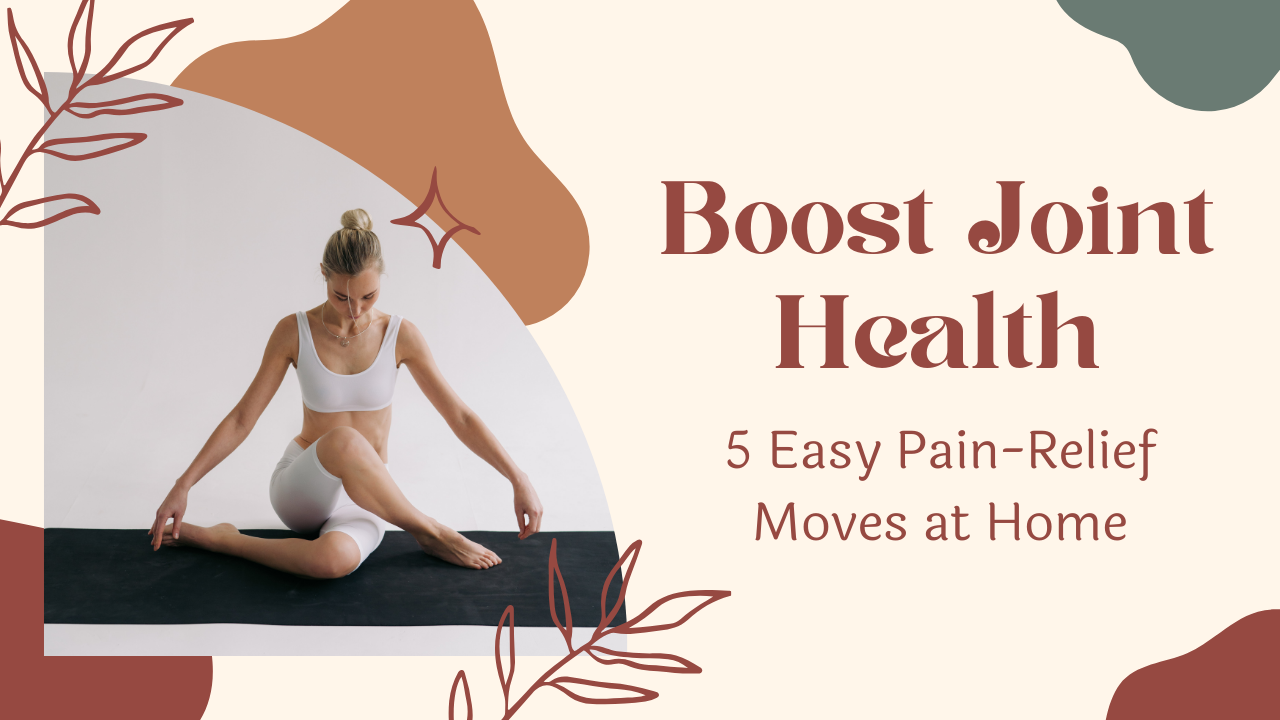Joints are important parts of the body where two bones meet. They allow us to move freely and comfortably. Just like hinges on a door, joints help our bodies bend, twist, and turn. Major joints such as the knees, hips, shoulders, and elbows support everyday actions like walking, lifting, and reaching.
When your joints are healthy, moving feels easy and natural. You can go about your day without thinking twice about how your body moves. Good joint health plays a big role in staying active, flexible, and pain-free.
However, when joints become weak or damaged, even small actions can hurt. This can happen due to age, injury, arthritis, or sitting too much. Stiffness, pain, or swelling can make it hard to do simple things like climbing stairs or opening a jar. Joint problems can affect your comfort, movement, and overall quality of life. Taking care of your joints is very important.

Why Joint Health Matters
Maintaining joint health isn’t just about avoiding pain—it’s about preserving your independence and mobility as you age. Here’s why it matters:
Maintains Mobility and Flexibility
Healthy joints make movement easy and comfortable. They help you get out of bed, climb stairs, walk, bend, and stay active throughout the day. With strong joints, you can play with your kids or grandkids, lift things, and enjoy daily tasks without pain or stiffness. Good joint health is important for staying independent and mobile as you age. When your joints are working well, life feels smoother and more enjoyable. Taking care of your joints helps you stay active and free from discomfort.
Reduces the Risk of Injury
Strong and stable joints help your body move safely and smoothly. When joints are weak, stiff, or unstable, you’re more likely to suffer injuries like sprains, strains, or falls. Keeping your joints healthy improves balance and coordination, making everyday activities safer. Whether you’re walking on uneven ground or lifting something heavy, good joint support reduces the risk of sudden injuries. Regular stretching and strength exercises can keep your joints in shape and help you avoid pain and accidents
Supports an Active Lifestyle
Healthy joints are key to enjoying an active and fulfilling life. Whether you love walking, hiking, gardening, or dancing, strong joints help you move freely and stay energized. When your joints feel good, you’re more likely to stay involved in your favourite activities. Joint care keeps you mobile and engaged as you age. Regular movement, low-impact exercise, and a balanced routine help your joints stay flexible and support an active, joyful lifestyle.
Prevents Chronic Conditions
Taking care of your joints helps prevent or manage chronic issues like osteoarthritis and rheumatoid arthritis. Regular movement keeps joints flexible and the cartilage nourished, reducing wear and tear. Staying active also improves circulation and reduces stiffness, which can slow down joint damage over time. Good joint care, including proper posture, exercise, and stretching, plays a big role in preventing painful long-term conditions. It’s a simple way to protect your future health and mobility.
Improves Overall Quality of Life
Healthy, pain-free joints can improve many parts of your life. You sleep better, move easier, and feel more positive when you’re not dealing with constant joint pain. Staying active supports your mental health, boosts your mood, and helps you enjoy everyday moments more. Whether it’s going out with friends or playing with your grandchildren, joint comfort makes everything easier. Taking care of your joints now helps you feel better physically and emotionally in the long run.
Causes of Joint Pain

Joint pain can come from many different causes. Knowing what’s behind the pain can help you choose the right way to manage it:
Arthritis: Conditions like osteoarthritis and rheumatoid arthritis can cause swelling, stiffness, and joint damage.
Injury or Overuse: Strains, sprains, or repeated movements can lead to joint discomfort over time.
Poor Posture: Sitting or standing the wrong way puts stress on your joints.
Lack of Physical Activity: Not moving enough can make joints stiff and weak.
Aging and Wear-and-Tear: As we get older, joints naturally lose strength and flexibility.
Excess Weight: Carrying extra body weight adds pressure to joints, especially in the knees and hips.
The good news? Regular exercise is a simple and powerful way to reduce joint pain and improve movement.
How Exercise Helps Joint Pain
You might think rest is the best cure for joint pain, but in most cases, gentle, targeted movement is more beneficial. Exercise can:
Strengthen muscles around joints: Exercise helps build stronger muscles that support and protect your joints. This added strength reduces the stress placed directly on the joints, helping you move more safely and comfortably.
Increase flexibility and range of motion: Regular movement keeps your joints from becoming stiff. Stretching and gentle exercises help maintain or improve flexibility, allowing your joints to move more freely and with less pain.
Promote blood circulation: Physical activity boosts blood flow, which helps deliver oxygen and nutrients to your joints. This nourishment supports joint health and helps keep the surrounding tissues in good condition.
Aid weight management: Staying active helps control your body weight. Less weight means less pressure on major joints like the knees, hips, and lower back, reducing strain and discomfort during daily activities.
Release endorphins: Exercise triggers the release of endorphins—your body’s natural pain relievers. These chemicals not only reduce joint pain but also help lift your mood and reduce stress.
Precautions Before You Start
Before you begin any exercises, it’s important to take a few precautions to keep your joints safe and your workout effective:
Always warm up first: Start with light stretching or a short walk to get your body moving and your joints ready. This helps reduce stiffness and lowers your risk of injury.
Take it slow and easy: Begin at a gentle pace, especially if you’re new to exercise or dealing with joint pain. Pay attention to how your body feels—never push through sharp or intense pain.
Focus on proper form: Moving correctly helps you get the most benefit from each exercise and protects your joints from strain or injury. If you’re unsure about form, consider watching a demo or asking a professional.
Dress for comfort: Wear loose, breathable clothing and choose shoes that offer good support and cushioning to protect your joints as you move.
Check with a doctor if needed: If you have serious joint problems or any medical condition, it’s best to talk to your doctor or physical therapist before starting new exercises.
Now that you’re set, let’s dive into the good stuff—5 simple, effective exercises you can do right at home to support healthy, happy joints!
5 Simple Exercises for Joint Pain Relief You Can Do at Home
- Seated Leg Extensions – For Knee Pain Relief

Why It Helps:
This exercise targets and strengthens the quadriceps (the muscles in the front of your thighs), which are essential for supporting the knee joint. By strengthening these muscles, you can help stabilize the knee and reduce pain or discomfort, especially when standing or walking.
How to Do It:
Start by sitting on a sturdy chair with your back straight and feet flat on the ground. Keep your posture relaxed but firm, avoiding any slouching. Slowly extend your right leg straight out in front of you until it is parallel to the ground. Hold the position for about 5 seconds, then gently lower your leg back down to the starting position. Repeat the movement 10 to 15 times before switching to the other leg.
Tips:
To make this exercise more challenging, you can add light ankle weights to increase resistance and further strengthen your muscles. Remember to keep your core engaged throughout the exercise to maintain good posture and avoid slumping or leaning back. This will help ensure that the focus remains on your legs and knees while minimizing strain on other parts of your body.
- Wall Push-Ups – For Shoulder and Wrist Relief
Why It Helps:
Wall push-ups are a great way to strengthen your upper body without putting too much pressure on your joints, particularly your shoulders and wrists. Unlike regular push-ups that require you to support your body weight on the ground, wall push-ups reduce the load on your wrists and shoulders, making them a joint-friendly option for building strength.
How to Do It:
Stand facing a wall, keeping a comfortable arm’s length between you and the wall. Place your palms flat on the wall, keeping them shoulder-width apart. Slowly bend your elbows to lower your chest toward the wall, keeping your body straight from head to toe. Once your chest is close to the wall, push back up to the starting position. Aim to do 10–15 repetitions, depending on your comfort level.
Tips:
To get the best results and avoid strain, make sure your body stays in a straight line throughout the movement. Avoid arching your back or letting your hips drop, as this could put unnecessary stress on your spine. Move at a slow, controlled pace, and remember to breathe deeply—inhale as you lower your body, and exhale as you push back to the starting position. This controlled movement will help you engage your muscles more effectively while minimizing joint strain.
- Hip Bridges – For Lower Back, Hip, and Knee Support

Why It Helps:
Hip bridges are excellent for strengthening the glutes and lower back muscles, which play a crucial role in stabilizing the hips and knees. By targeting these muscles, you can improve overall lower body strength and support, reducing stress on the knees and lower back. This exercise also helps to improve posture and balance, especially in the lower body.
How to Do It:
Begin by lying on your back with your knees bent and feet flat on the floor, positioned about hip-width apart. Rest your arms by your sides with palms facing down. Press through your heels, squeeze your glutes, and lift your hips off the floor until your body forms a straight line from your shoulders to your knees. Hold the bridge position for about 5 seconds, then gently lower your hips back down to the floor. Repeat this movement for 10–12 repetitions.
Tips:
Focus on using your lower body muscles to lift your hips rather than pushing with your arms. Keep your back neutral—avoid over-arching your lower back during the lift, as this could lead to discomfort or strain. Perform the movement slowly and controlled to ensure maximum engagement of your glutes and lower back muscles.
- Ankle Circles – For Ankle and Foot Flexibility
Why It Helps:
Ankle circles are great for improving flexibility and mobility in the ankles, which can help reduce stiffness and enhance balance. This exercise is particularly useful for people who spend long hours sitting, as it promotes circulation and keeps the ankle joints supple, reducing the risk of injury.
How to Do It:
Sit comfortably in a chair or lie on your back with one leg extended. Lift your leg slightly off the ground and slowly rotate your ankle in a circular motion. Perform 10 circles in a clockwise direction, then switch and do 10 circles counterclockwise. Repeat the process with the other ankle.
Tips:
For maximum benefits, perform this exercise daily, especially if you sit for extended periods. You can easily do this exercise while watching TV, making it a simple and effective way to improve ankle mobility without taking up much time.
- Cat-Cow Stretch – For Spine, Neck, and Shoulder Relief
Why It Helps:
The Cat-Cow stretch is an effective way to improve flexibility in the spine while also relieving tension in the neck, shoulders, and back. This movement helps stretch the muscles along your spine, promoting better posture and reducing stiffness. It also encourages the flow of fluid around your spinal discs, which can support overall back health.
How to Do It:
Start by getting on all fours with your hands directly under your shoulders and knees under your hips. Inhale deeply as you arch your back, lifting your head and tailbone toward the ceiling (Cow pose). Then, exhale as you round your spine upward, tucking your chin toward your chest (Cat pose). Slowly move between these two positions for 10–15 repetitions, focusing on your breathing.

Tips:
Ensure that the movement is fluid and controlled, and synchronize your breath with each motion. This stretch is especially beneficial when done in the morning to wake up your spine or before bed to release tension built up during the day. It’s a simple yet effective way to support spinal health and relieve tightness in the upper body.
Bonus Tips to Support Joint Health
In addition to exercise, here are other habits that promote joint health:
Stay Hydrated
Joint cartilage, which acts as a cushion and lubricant for your joints, is primarily made up of water. Staying hydrated is essential for maintaining this natural cushioning. Proper hydration helps ensure that your joints remain lubricated, reducing friction and wear-and-tear. When your body is well-hydrated, it can better handle physical activities and protect the joints from discomfort or injury.
Eat Anti-Inflammatory Foods
Incorporating anti-inflammatory foods into your diet can significantly benefit joint health. Omega-3 fatty acids, found in foods like salmon, walnuts, and flaxseeds, have been shown to reduce inflammation in the body. Additionally, antioxidant-rich foods like berries, leafy greens, and colorful vegetables help combat oxidative stress, which can contribute to joint pain and stiffness. On the other hand, it’s important to limit processed, sugary foods, as they can exacerbate inflammation and worsen joint discomfort over time.
Maintain a Healthy Weight
Carrying excess weight places unnecessary strain on your joints, particularly the weight-bearing ones like your knees, hips, and lower back. Maintaining a healthy weight can help reduce the pressure on these joints, minimizing the risk of developing joint pain, arthritis, or other related conditions. By keeping your weight in check, you not only protect your joints but also promote overall mobility and comfort in your day-to-day activities.
Use Supportive Footwear
Wearing shoes that provide proper arch support and cushioning can make a big difference in protecting your joints. Footwear with adequate support helps absorb shock and reduces the stress placed on joints, particularly in the feet, knees, and hips. This is especially important during activities that involve prolonged standing, walking, or running, as the right shoes can prevent joint fatigue and pain.
Take Breaks from Sitting
Sitting for long periods can lead to joint stiffness and discomfort, particularly in the hips, knees, and lower back. To keep your joints flexible, it’s important to take regular breaks and move around every 30–60 minutes. Whether it’s standing up, stretching, or walking around, these short breaks help reduce the build up of stiffness and improve blood flow to your joints, supporting better mobility and overall joint health.
Final Thoughts: Take Control of Your Joint Health
Joint pain can be challenging, but it doesn’t have to control your life. With a bit of effort and commitment, you can reduce discomfort, increase your range of motion, and build strength over time. The best part is, you don’t need to visit a gym or buy expensive equipment to get started. These 5 simple exercises are all you need to begin improving your joint health right from the comfort of your home.
It’s important to remember that consistency is crucial. Start with gentle movements and gradually increase the intensity as your body becomes stronger. Listen to your body and avoid pushing too hard, especially if you’re just starting. Celebrate each bit of progress, whether it’s a small improvement in flexibility or reduced pain during your daily activities.
By sticking to a regular exercise routine, you’ll not only strengthen your joints but also improve your overall mobility and quality of life. Your joints will appreciate the care and attention, and you’ll feel the benefits in your everyday movements. Stay patient, stay consistent, and over time, you’ll notice a significant difference in how your body feels.
🧾 (FAQs)
- Can I do these joint exercises every day ?
Yes! These exercises are low-impact and gentle enough to be done daily. In fact, regular movement is beneficial for joint health. Just be sure to listen to your body and rest if you feel sore or fatigued. - What if I feel pain while doing the exercises ?
You should never push through sharp or severe pain. Mild discomfort is okay when you’re starting out, but if any exercise causes pain, stop and consult a physical therapist or healthcare provider before continuing. - Do I need any equipment for these exercises ?
Nope! All the exercises listed can be done using just your body weight and household items like a sturdy chair or wall. Optional equipment like yoga mats or light ankle weights can add comfort or challenge but aren’t necessary. - How long does it take to see results from joint exercises ?
Many people begin to feel relief in 2 to 4 weeks with consistent practice. Improvements in flexibility, strength, and reduced pain often continue with long-term commitment. - Are these exercises safe for people with arthritis ?
Yes, most of these exercises are safe and even recommended for people with osteoarthritis or early-stage rheumatoid arthritis. However, always consult your doctor or physical therapist to tailor a routine that fits your condition.

